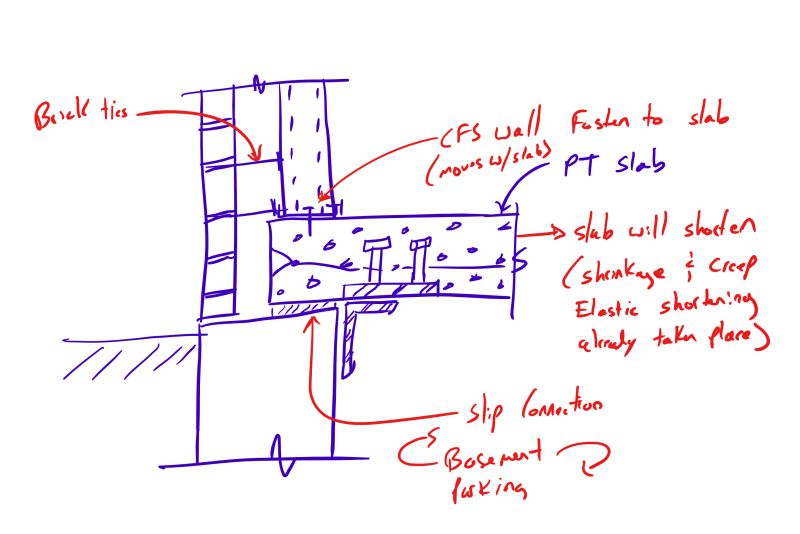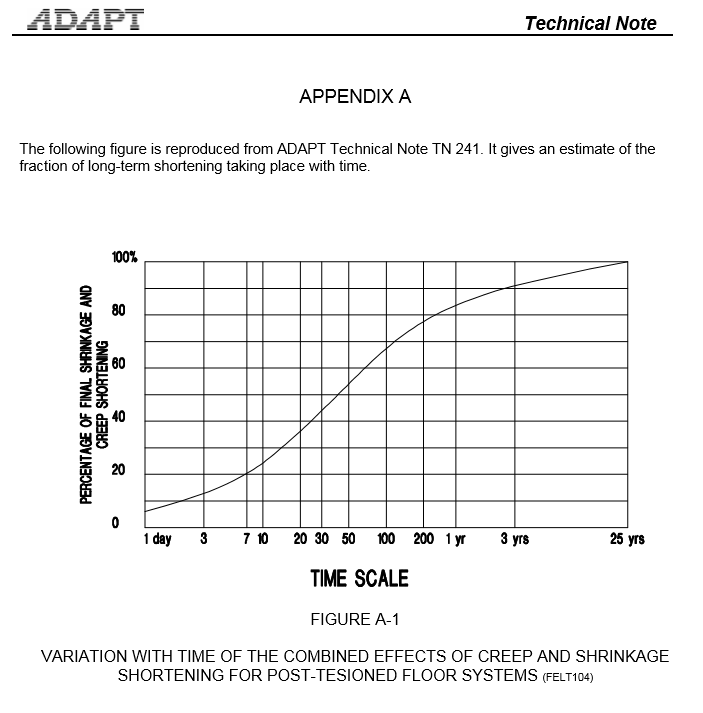RFreund
Structural
- Aug 14, 2010
- 1,885
A few questions related to shortening related cracks and forces.
Background for reference:
A muliti-story building (say 3-4 stories) w/ a basement for Parking. The construction is PT-Slabs supported by concrete columns and shear walls. To reduce RTS cracking at the first floor but still support the walls for out of plane forces we have released the slab as shown below.
Questions:
1. In the section below what are your thoughts on having issues with the CFS framing moving with the slab and causing issues with the brick? Supposedly the cladding would be installed about 2 months after this floor is constructed. I'm tempted to say this will be ok...

2. Does this chart from ADAPT seem right for the amount of shortening that will occur at 60 days?

3. At the upper levels the columns would be more flexibility and may allow for more uniform cracking. However, do you typically design the columns for shortening forces? Therefore the outer columns would have significantly more reinforced (due to shortening) than the interior columns. Or could you distribute this force more evenly to the columns so how. I feel like I see this ignored sometimes.
4. Getting back #1 - lets say I didn't connect the CFS to the slab and somehow connected it to the fdn wall. The top of the wall would still move inward so I would still get differential movement, but in this case it would be over a 10' span rather than 6". Any better?
Thanks!
EIT
Background for reference:
A muliti-story building (say 3-4 stories) w/ a basement for Parking. The construction is PT-Slabs supported by concrete columns and shear walls. To reduce RTS cracking at the first floor but still support the walls for out of plane forces we have released the slab as shown below.
Questions:
1. In the section below what are your thoughts on having issues with the CFS framing moving with the slab and causing issues with the brick? Supposedly the cladding would be installed about 2 months after this floor is constructed. I'm tempted to say this will be ok...

2. Does this chart from ADAPT seem right for the amount of shortening that will occur at 60 days?

3. At the upper levels the columns would be more flexibility and may allow for more uniform cracking. However, do you typically design the columns for shortening forces? Therefore the outer columns would have significantly more reinforced (due to shortening) than the interior columns. Or could you distribute this force more evenly to the columns so how. I feel like I see this ignored sometimes.
4. Getting back #1 - lets say I didn't connect the CFS to the slab and somehow connected it to the fdn wall. The top of the wall would still move inward so I would still get differential movement, but in this case it would be over a 10' span rather than 6". Any better?
Thanks!
EIT
